Founding
Between 1873 and 1977, the Holy Cross Monastery was a Roman Catholic monastery atop Mt. Adams in Cincinnati, which served a parish of the same name. It was founded by the Passionists, who were first brought to Mt. Adams in 1871 by John Baptist Purcell, the Archbishop of Cincinnati, to run Immaculata Church, founded in 1860. [2]
The first Passionist pastor of Immaculata Parish, Guido Matassi, C.P., immediately saw that the rectory of the parish would be inadequate to their needs as a semi-monastic community. By chance, the building which used to house the Mitchel Observatory (later the Cincinnati Observatory), located only two blocks away from Immaculata Church, was being abandoned due to the effects of industrial pollution. [3]
The terms of the will of the donor of the property which had housed the observatory, however, required the return of the property to his heirs. When Matassi approached them about purchasing the property, they demanded a price which he would not pay. With the encouragement and support of Sarah Peter, daughter of an early Governor of Ohio and a noted convert to Catholicism, the city stepped in and purchased the property from the heir. The following year Matassi signed a 99-year lease with the City of Cincinnati for a building and a property atop Mt. Adams. The Passionists remodeled the structure and added a third floor.
The Church and Monastery of the Holy Cross
The first Church of the Holy Cross, made out of wood, was finished in 1873, standing next to the monastery, but in 1895 it was replaced by a large, permanent structure. It served mostly Irish immigrants. Holy Cross added a grade school in 1891. A weekly novena in honor of St. Gabriel began in 1929. [4]
In 1899 the monastery was condemned as unsafe, and a new edifice was built in the same location. It was dedicated on June 9, 1901. Underneath the monastery was "The Grotto". Immaculata parish had a Holy Week tradition of people praying the rosary while climbing the 125 steps to the church. After "praying the steps", they would then proceed to "The Grotto" at Holy Cross. It was believed that praying there would enhance the possibility of a cure, and there was a wide assortment of crutches at "The Grotto". [5]
Sale and Redevelopment
In 1970 Holy Cross Parish was merged with Immaculata Parish, also located atop Mt. Adams. The combined parish has since been known as Holy Cross-Immaculata. When Holy Cross closed, a statue of St. Patrick was surreptitiously relocated to Immaculata. The Ancient Order of Hibernians annually re-enact St. Patrick's "liberation" and celebrate with a luncheon and Mass at Immaculata. [4]
By the mid-1970s, the Passionist community decided to consolidate their operations to Chicago. [3] The Passionists made the decision to close Holy Cross Monastery in 1976 and the building was sold. [5] After passing through a couple of owners, the monastery is now the corporate headquarters of Towne Properties, a property management company. The church was renovated in 2014 as an event center hosting weddings, receptions, and corporate functions. [6] A chapel garden was installed to complement the newly renovated former church. [7] With the assistance of Towne Properties employees, a statue of an angel was installed n the property by parishioners of Immaculata on a pedestal that previously held one of St. Gabriel. [4]

The Cincinnati Observatory, known locally as Mt. Lookout Observatory, is located in Cincinnati, Ohio on top of Mount Lookout. It consists of two observatory buildings housing an 11-inch (28 cm) and 16 inch (41 cm) aperture refracting telescope. It is the oldest professional observatory in the United States. It was a key facility for astronomical research and education at the University of Cincinnati and currently operates as a 19th-century observatory. There are regular viewings through both historical telescopes as well as tours and additional programs. The observatory also has an extensive outreach program, providing astronomical education for the Ohio/Kentucky/Indiana region.
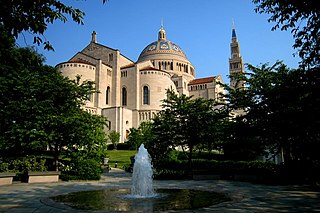
Maginnis & Walsh was a Boston-based architecture firm started by Charles Donagh Maginnis and Timothy Francis Walsh in 1905. It was known for its innovative design of churches in Boston in the first half of the 20th century.
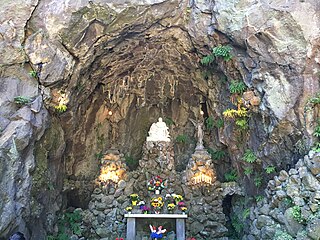
The National Sanctuary of our Sorrowful Mother, popularly known as The Grotto, is a Catholic outdoor altar and sanctuary located in the Madison South district of Portland, Oregon, United States. Constructed in 1924, the sanctuary covers 62 acres (25 ha), set both at the foot of, and atop, a 110 foot (34 m) cliff. It is a ministry of the Servite Friars, Order of Friar Servants of Mary. A large meditation hall whose main chamber is at clifftop level extends down to the foot of the cliff; the cross on the hill is visible many miles away. In addition to a church, there are several thousand feet of trails, including a trail of the Stations of the Cross, along which visitors may pass in contemplation through botanical gardens. The Grotto also features a full-service Conference Center, and a Gift Shop.

Gabriel of Our Lady of Sorrows was an Italian Passionist clerical student. Born to a professional family, he gave up ambitions of a secular career to enter the Passionist congregation. His life in the monastery was not extraordinary, yet he followed the rule of the congregation perfectly and was known for his great devotion to the sorrows of the Virgin Mary. He died from tuberculosis at the age of 23 in Isola del Gran Sasso, in the province of Teramo. He was canonized by Pope Benedict XV in 1920.

The Passionists, officially named the Congregation of the Passion of Jesus Christ, abbreviated CP, are a Catholic clerical religious congregation of pontifical right for men, founded by Paul of the Cross in 1720, with a special emphasis on and devotion to the Passion of Jesus Christ. A known symbol of the congregation is the labeled emblem of the Sacred Heart of Jesus, surmounted by a cross. This symbol is often sewn into the attire of its congregants.
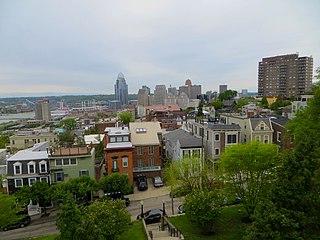
Mount Adams is one of the 52 neighborhoods of Cincinnati, Ohio. Located on a hill immediately east of downtown Cincinnati, it is south of Walnut Hills, southwest of East Walnut Hills, and west of the East End. The population was 1,578 at the 2020 census.

The Church of the Immaculata, or Immaculata Church, is a Roman Catholic church atop Mt. Adams, a neighborhood in Cincinnati, Ohio. The church commemorates the Immaculate Conception and serves the Holy Cross–Immaculata Parish in the Archdiocese of Cincinnati. Located at 30 Guido Street, it allows a scenic view of the Ohio River below from one of the highest points in Cincinnati.

St. Paul Church is a former Roman Catholic church located on the southeastern corner of Twelfth and Spring Streets in Cincinnati, Ohio, United States, in the city's Pendleton neighborhood.
Daniel Bible Foley, also known by his religious name Theodore Foley, was a Roman Catholic priest and the superior general of the Congregation of the Passion of Jesus Christ from 1964 to 1974. On May 9, 2008, the cause for beatification and canonization of Foley was opened in Rome.

Johann Heinrich Koehnken (1819–1897) was an American organ builder in Cincinnati, Ohio who worked under Matthias Schwab (1808–1862) and with Gallus Grimm (1827–1897). Their organs remain in use at the Isaac M. Wise Temple and other locations.
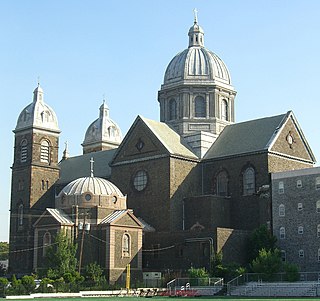
The Monastery and Church of Saint Michael the Archangel, known locally as Saint Michael's Monastery Church, is a state and national historic place in Union City, New Jersey, United States. Formally opened in 1869 and completed in 1875, the grounds of the complex are bounded West Street and Summit Avenue between 18th and 21st Streets. The small street leading to its front entrance from the east is called Monastery Place. At one time the largest Roman Catholic church in Hudson County, it has since become home to a Presbyterian congregation while part of the grounds are used for housing and education. At one time its walls were adorned by artwork by Hildreth Meière, until rain damage prompted their removal from public view.

Holy Family Catholic Church is a historic Roman Catholic church in Wayne Township, Darke County, Ohio, United States. Located in the unincorporated community of Frenchtown, it houses an active congregation, and it has been accorded historic site status because of its well-preserved Gothic Revival architecture.

Holy Rosary Catholic Church is a Roman Catholic parish on the east side of St. Marys, Ohio, United States. Established in 1852, the church has been recognized for its historic 1860s church building, which was demolished amid a period of growth in the 1970s and replaced with a modernist structure.
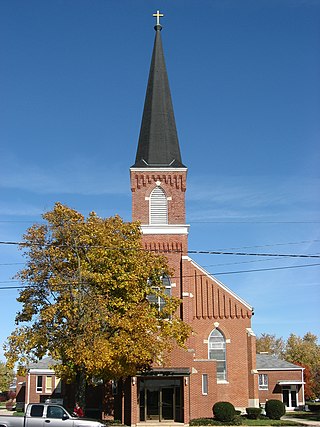
St. Nicholas Catholic Church is a historic Roman Catholic church in Osgood, Ohio, United States. Built in the first years of the 20th century, it houses one of the newest parishes in a heavily Catholic region of far western Ohio, but it has been recognized as a historic site for its architecture.

Irvington is a neighborhood in the Southwest District of Baltimore, located between Yale Heights neighborhood to the west and the Gwynns Falls neighborhood to the east. It was historically nicknamed "Skulltown" for its three large cemeteries: Loudon Park, Mount Olivet and New Cathedral.

St. Adalbert Polish Catholic Church is a historic church at 1511 Valley Street in Dayton, Ohio.

The Steps of Cincinnati refers to roughly 400 sets of city-owned steps in Cincinnati, Ohio, in the United States. The steps are an unusual and integral mode of transportation in the city. In addition to practical use, the steps offer recreational users exercise and serve as a scenic attraction to tourists.
The Sanctuary of St. Gabriel of Our Lady of Sorrows is located at the foot of the Gran Sasso, in the municipality of Isola del Gran Sasso, in Teramo province, Abruzzo region, Italy. The shrine receives an average of 2 million visitors a year and is thus one of the 15 most visited sanctuaries in the world.

Holy Cross Church is a sandstone Catholic church in the Lombardic Romanesque style located at the intersection of the Crumlin Road and Woodvale Road in Ardoyne, Belfast. The current church replaced an earlier house of worship that had stood on the same site since 1869.

















